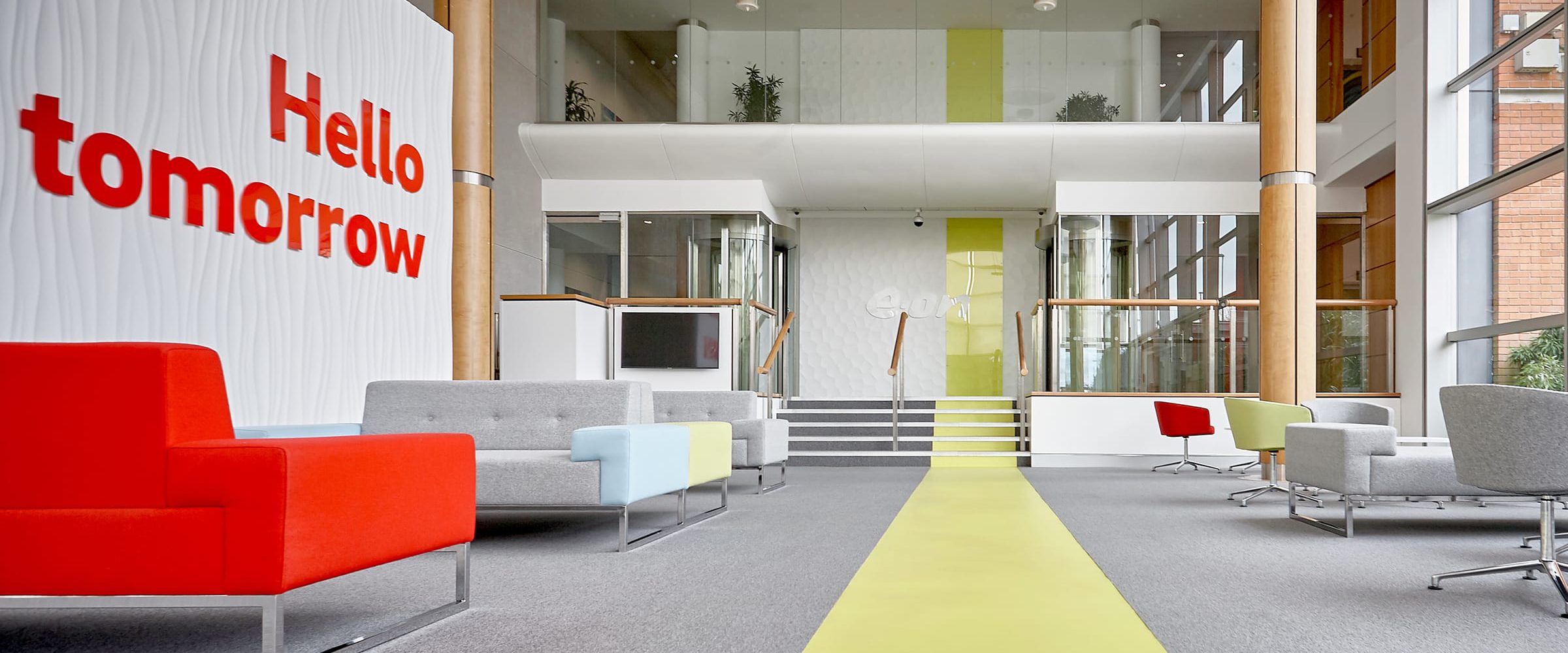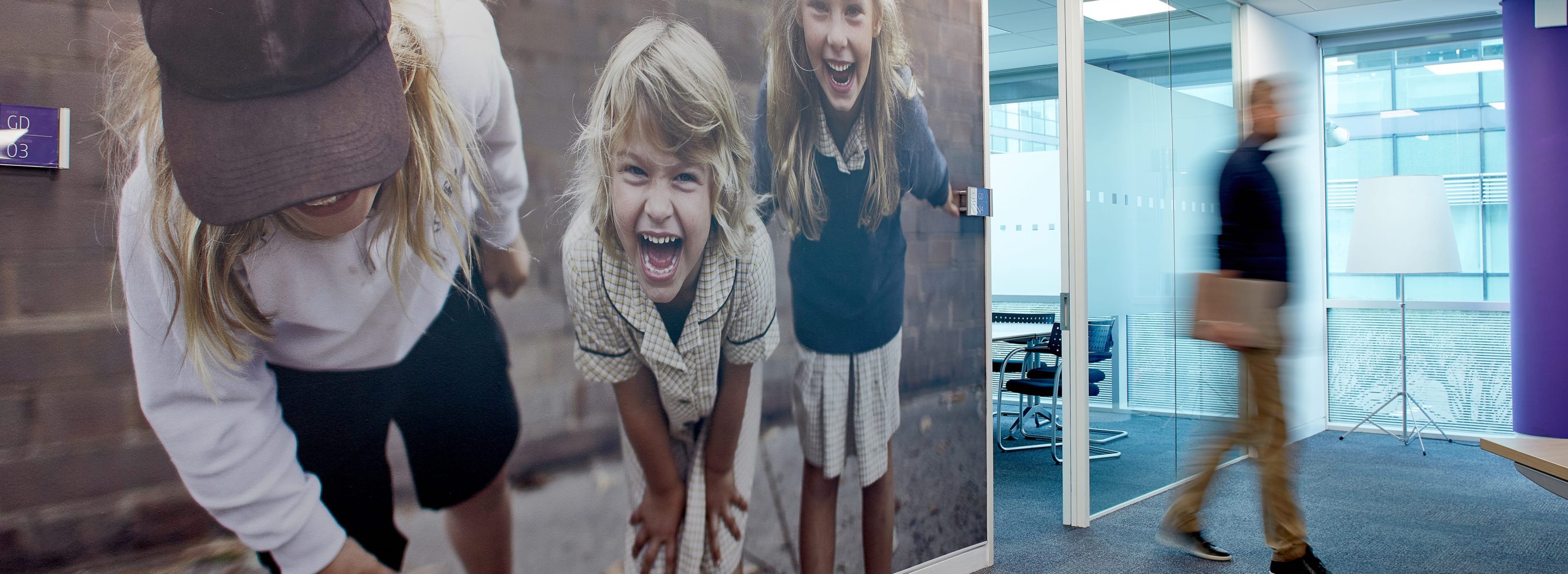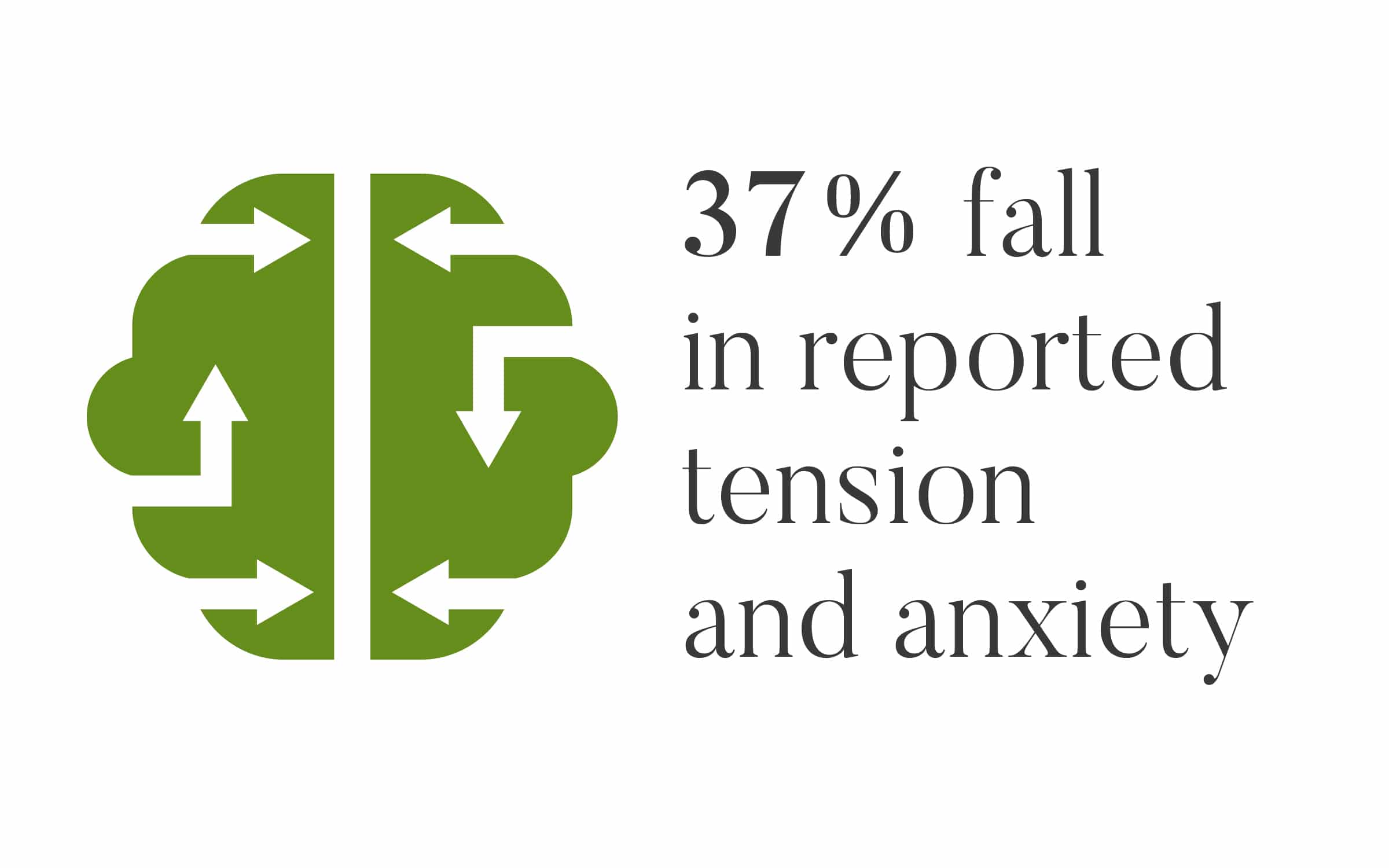Is your interior branding damaging your employee engagement?

According to a survey conducted by the Independent, a full-time employee in Britain spends an average of 34 hours and 26 minutes at work a week, totalling 1,791 hours a year, and 84,171 hours in the course of their career. And in this increasingly competitive world, it’s no surprise that employees are looking for that extra something when choosing or staying with an employer – flexibility, wellbeing and the wow factor.
BCO’s research on Improving Productivity in the Workplace 2018 found that “optimising the indoor environment leads to improvements in staff cognitive capability, speed, and accuracy of work and output”.
Following the completion of widely successful turn-key interior rebranding projects for our clients E.ON and BT, here’s our breakdown of the importance of relevant and engaging interior branding.
On average, a full-time employee in Britain spends 34 hours and 26 minutes at work a week, totalling 1,791 hours a year, and 84,171 hours in the course of their career
Creating a better user experience
Just as with any discipline of branding and marketing, focusing on user experience is key to delivering success. The best office interior branding schemes really look at the whole space, the people inhabiting it and how they use it or plan to use it, addressing some of the common complaints whilst building in flexibility. There certainly can’t be a ‘standard fit’ in a modern office nowadays.
Younger employees and graduates work in a less traditional way, often completing most of their work in relaxed scenarios, away from the desk, on laptops and are more comfortable with noise and distractions. However, for more private or one-to-one conversations, quieter areas or meeting rooms are required. There’s also the consideration for large-group announcements, team updates or even experiential, but these won’t be needed 100% of the time. Therefore, when planning your interior branding, it’s good to design in flexibility and the ability to subdivide and open up spaces with moveable screens, walls, room dividers and furniture.
Research across Fortune 500 companies surprisingly demonstrates space isn’t being used effectively in today’s working environment:
- Workstations are unoccupied 60% of the time.
- Private offices are unoccupied 77% of the time.
- Conference room seating is rarely used to capacity.
All this goes to prove the changing needs of today’s workforce, personal preference to ways of working and the different way business is being carried out.
In one of our recent projects for E.ON colleagues were so responsive and engaged with their new collaborative, flexible spaces they even proudly posted pictures of their cool new offices across social media.
Attracting and keeping valuable talent
We’re all seduced by interiors – whether it be choosing your boutique hotel for the weekend away, choosing a new house or picking which restaurant to visit, the same applies to the workplace. In the creative agency world, we’re very aware of the expectations which are set and the reaction clients and visitors have to our own offices.
As we spend so much of our lives at work, being comfortable and having a well-equipped and inspirational place to work is a key consideration when potential employees choose where to work. Salary remains the main influence on job attractiveness but from HASSELL and Empirica’s report ‘Does workplace affect employee attraction?’ they discovered that candidates listed culture and facilities of the workplace as being strong deciding factors. Interestingly, the combined scores outweighed salary.
- Salary (45%)
- Culture (32%)
- Facilities (16%)
And interestingly, respondents said they determined a good or bad workplace through the aesthetics even more than layout. Extra facilities like showers, lockers, and outdoor areas have a big impact as well, helping to demonstrate to employees that you value their wellbeing and offer functional facilities for their own lifestyle needs through your office’s interior branding.
Live the brand
There’s no one-size fits all solution for branding through interior design either. We might all be wowed by the latest Google and Instagram offices, but this isn’t appropriate for all companies and brands. Interiors, as with any brand activation, needs to be true to the values and personalities of the brand – not every brand is ‘fun’ or ‘quirky’.
For example, an employee slide may not be fitting for a solicitors’ office, but equally, a stark shuttered concrete wall is probably not the best solution for a pre-school nursery either. We work hard to really understand a brand, the building, employees and ambitions of the company to develop relevant and effective interior solutions that help bring the brand to life in a way that addresses all those criteria.
The International WELL Building Institute Standard found that: “when interior design reflects the corporate brand, culture and values it can enhance occupants’ sense of pride, connection to the organisation and engagement scores. A people-centric, attractive design will make the space more desirable to spend time in and promote clients.”
Employees working in an environment which reflects the brand, at every touchpoint from practical, functional spaces, to helpful technology, better understand the brand. This in turn helps them communicate the brand more effectively externally and become brand advocates themselves.

Investing in employees
Investing in interiors, even basic amenities, helps show employees that as a business you’re committed to their contentment. It doesn’t necessarily mean huge investment, little things make a big difference. Don’t just focus on reception areas and visitor spaces, the day-to-day working and functional spaces are arguably the most impactful to employees.
For example, if toilets are a bit dated, the bins are overflowing and the cleanliness isn’t quite what it should be, a deep clean, a lick of paint and addressing the basics can go a long way to improve the brand experience. And remember the brand essence should be felt across every touchpoint, even those hidden away.
Increase your productivity
Office interiors have also been proven to increase productivity to varying degrees. The British Council of Offices quotes increases of 2-3% on average, as the measurability of productiveness before and after improvements have proved scientifically hard to record. However, specific case studies for call centres with highly measurable work performance can demonstrate increased improvements. In one case study completed by Texas A&M Health Science Center School of Public Health, productivity was increased by 46% over 6 months in a single call centre when sit/stand desks were introduced to half the team compared to the productivity levels of the other half of staff using the pre-existing sit desks.
Improve employee wellbeing
Health and wellbeing are understandably becoming a central concern for office facilities and environment design. The highest accolade comes from the International WELL Building Standard, which assesses projects across a range of factors including air, water, nourishment, light, fitness, comfort, mind and innovation. Here, we just scratch the surface for a few areas which you can incorporate into your office interior branding, that are proven to have a big impact on employees:
- Biophilia: The practice of incorporating plants into workplaces has been shown to have incredibly positive effects on employee wellbeing. From living walls, to pot plants, adding a bit of greenery into the office has a huge range of benefits, including reducing stress, increasing productivity, and even reducing sickness and absence levels. These figures from CIPHR speak for themselves:
- 37% fall in reported tension and anxiety
- 58% drop in depression
- 44% decrease in anger and hostility
- 38% reduction in fatigue
- 15% increase in creativity
Aesthetically, plants can help soften harsh materials, contrasting with metals or concretes in modern buildings. They also act as air purifiers by removing CO2 and even some harsh chemicals such as benzene, trichloroethylene, and formaldehyde.
- Natural light: There’s some debate about the exact scientific benefits of natural light in the UK, but so much anecdotal and employee data confirms that natural light in offices improves positivity, mental wellbeing and attractiveness. In our experience, enhancing natural light with bright, neutral paint schemes helps too, even creating subspaces with glass panels or pods for more private areas without restricting daylight.
- Furniture density/configuration: It seems simple logic, but the layout of desks and work areas directly affect wellbeing and productivity due to a number of factors, including noise, concentration, collaboration and confidentiality. Just think of a packed train with so many people squeezed together: telephone conversations get louder, stress levels increase and that’s just after a few minutes. Space planning is key but if space is tight, it’s important to offer spaces where people can work more quietly, collaboratively or privately as necessary.

Final thoughts
Engaging office interior branding considers a whole host of aspects, from individual requirements to wellbeing and productivity. Aesthetics simply aren’t enough, there needs to be purpose and relevance to the brand, business, employees and customers. More often than not, collaboration in creating the project is also imperative, working with a range of internal stakeholders, external suppliers and contractors to maximise engagement and productivity.
Once successfully delivered, projects can really raise the morale of employees, help them better understand the brand and even facilitate better work interactions and improved productivity. Interior branding is key to engaging employees in your brand, and motivating and informing internal audiences.
If you need more information on producing engaging office interior branding projects, get in touch with us. We’d love to help! Alternatively, for the latest in employee engagement, head over to our Articles page.